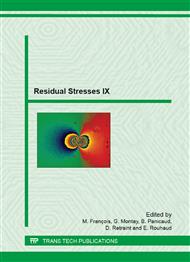[1]
M. Leitner and M. Stoschka, Influence of steel grade on the fatigue strength enhancement by high frequency peening technology on longitudinal fillet weld gusset. Journal of Engineering and Technology, 1(3) (2001) 80-90.
Google Scholar
[2]
G. Marquis, Engineering Fracture Mechanics, Failure modes and fatigue strength of improved HSS welds, 77 (2001) 2051-(2062).
DOI: 10.1016/j.engfracmech.2010.03.034
Google Scholar
[3]
P. J. Haagensen, S. M. Maddox, International Institute of Welding: March 2009 (Document IIW-XIII-2200r3-07 ).
Google Scholar
[4]
T. Hanlon, Y. N. Kwon, S. Suresh, Grain size effects on the fatigue response of nanocrystalline metals, Scripta Materialia, 49 (2003) 665-680.
DOI: 10.1016/s1359-6462(03)00393-2
Google Scholar
[5]
D. J. Child, G. D. West, R. C. Thomson, Assessment of surface hardening effects from shot peening on a Ni-based alloy using electron backscaterdiffraction techniques, Acta Materialia, 59 (2011) 4825-4834.
DOI: 10.1016/j.actamat.2011.04.025
Google Scholar
[6]
L. L. Shaw et al. A direct comparison in the fatigue resistance enhanced by surface severe plastic deformation and shot peening in a C-2000 superalloy Materials Science and Engineering A, 527 (2010) 986-994.
DOI: 10.1016/j.msea.2009.10.028
Google Scholar
[7]
EN 15305 standard: Test methods for residual stress analysis by X-ray.
Google Scholar
[8]
ISO 5817 - Welding - Fusion-welded joints in steel, nickel, titanium and their alloys (beam welding excluded) - Quality levels for imperfections.
DOI: 10.3403/30143072
Google Scholar


